Organizational Change Management: Leading Strategies Report Analysis
VerifiedAdded on 2023/06/03
|7
|977
|356
Report
AI Summary
This report provides an in-depth analysis of leading and managing organizational change, specifically within the context of the Royal Bank of Canada. It begins by outlining the crucial role of Human Resources in facilitating change, including their responsibilities in organizational design, establishin...
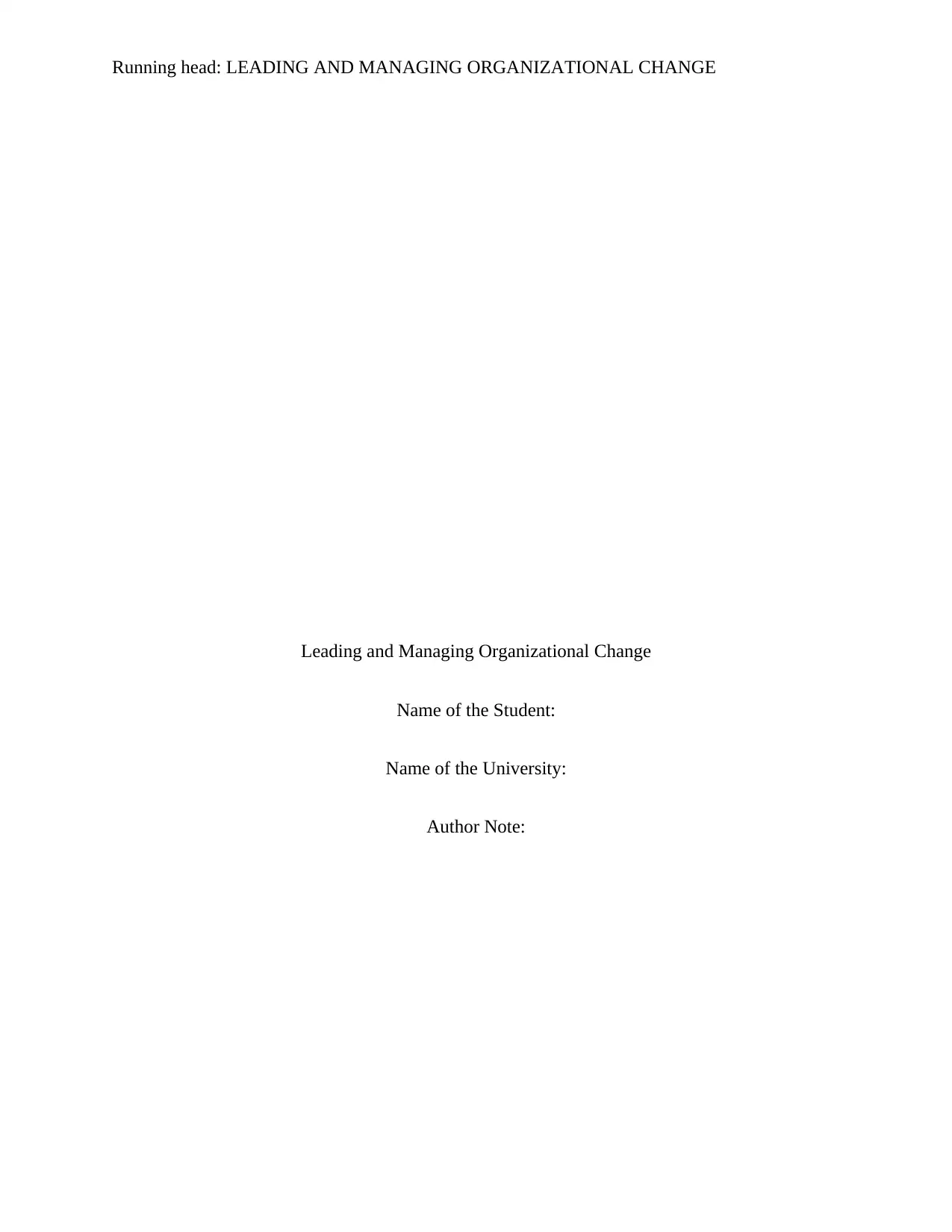
Running head: LEADING AND MANAGING ORGANIZATIONAL CHANGE
Leading and Managing Organizational Change
Name of the Student:
Name of the University:
Author Note:
Leading and Managing Organizational Change
Name of the Student:
Name of the University:
Author Note:
Paraphrase This Document
Need a fresh take? Get an instant paraphrase of this document with our AI Paraphraser
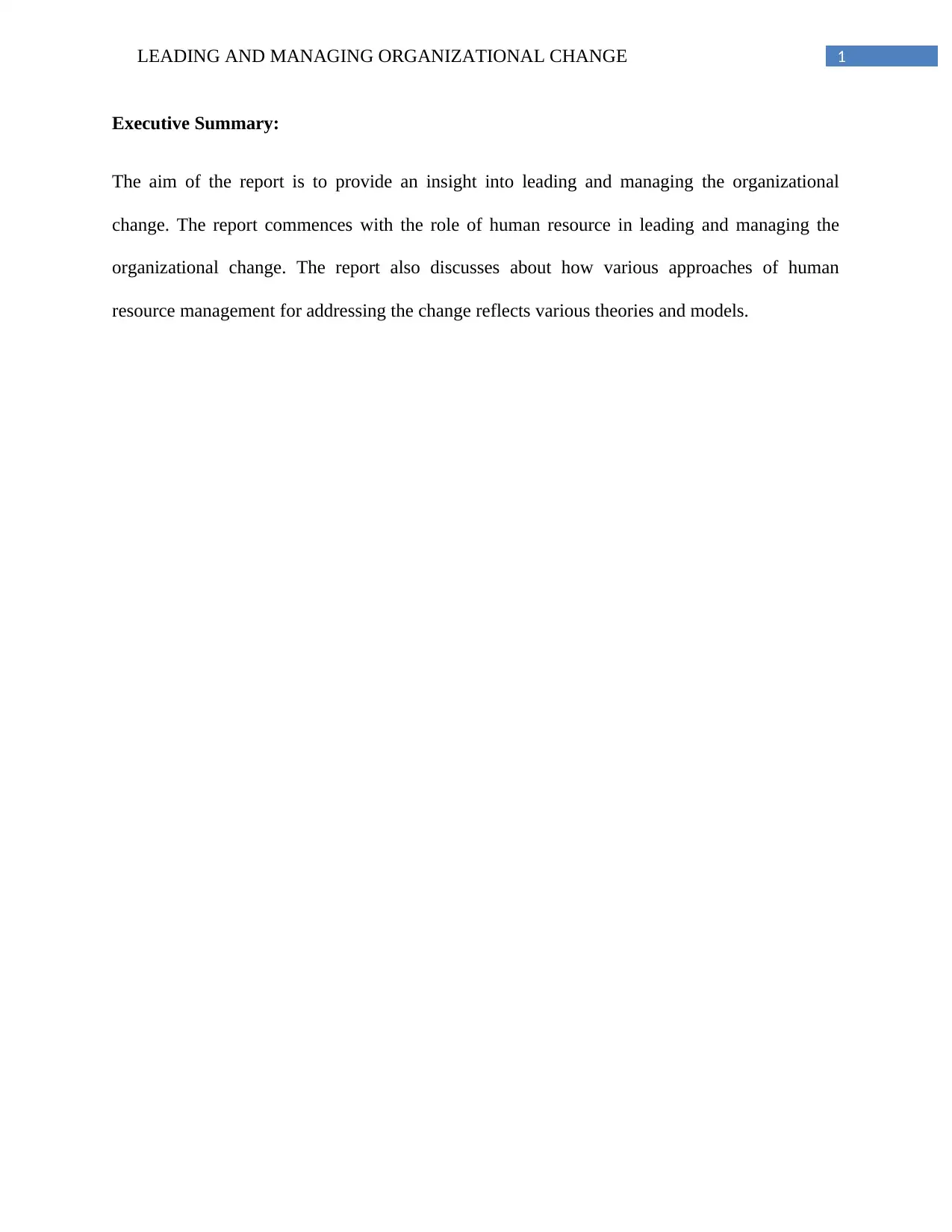
1LEADING AND MANAGING ORGANIZATIONAL CHANGE
Executive Summary:
The aim of the report is to provide an insight into leading and managing the organizational
change. The report commences with the role of human resource in leading and managing the
organizational change. The report also discusses about how various approaches of human
resource management for addressing the change reflects various theories and models.
Executive Summary:
The aim of the report is to provide an insight into leading and managing the organizational
change. The report commences with the role of human resource in leading and managing the
organizational change. The report also discusses about how various approaches of human
resource management for addressing the change reflects various theories and models.

2LEADING AND MANAGING ORGANIZATIONAL CHANGE
Table of Contents
Introduction:....................................................................................................................................4
Role of HR in Leading and Managing Organizational Change.......................................................4
Approaches of HRM for Addressing Change that Reflects Theories and Models of HRM...........5
Conclusion:......................................................................................................................................6
References:......................................................................................................................................7
Table of Contents
Introduction:....................................................................................................................................4
Role of HR in Leading and Managing Organizational Change.......................................................4
Approaches of HRM for Addressing Change that Reflects Theories and Models of HRM...........5
Conclusion:......................................................................................................................................6
References:......................................................................................................................................7
You're viewing a preview
Unlock full access by subscribing today!
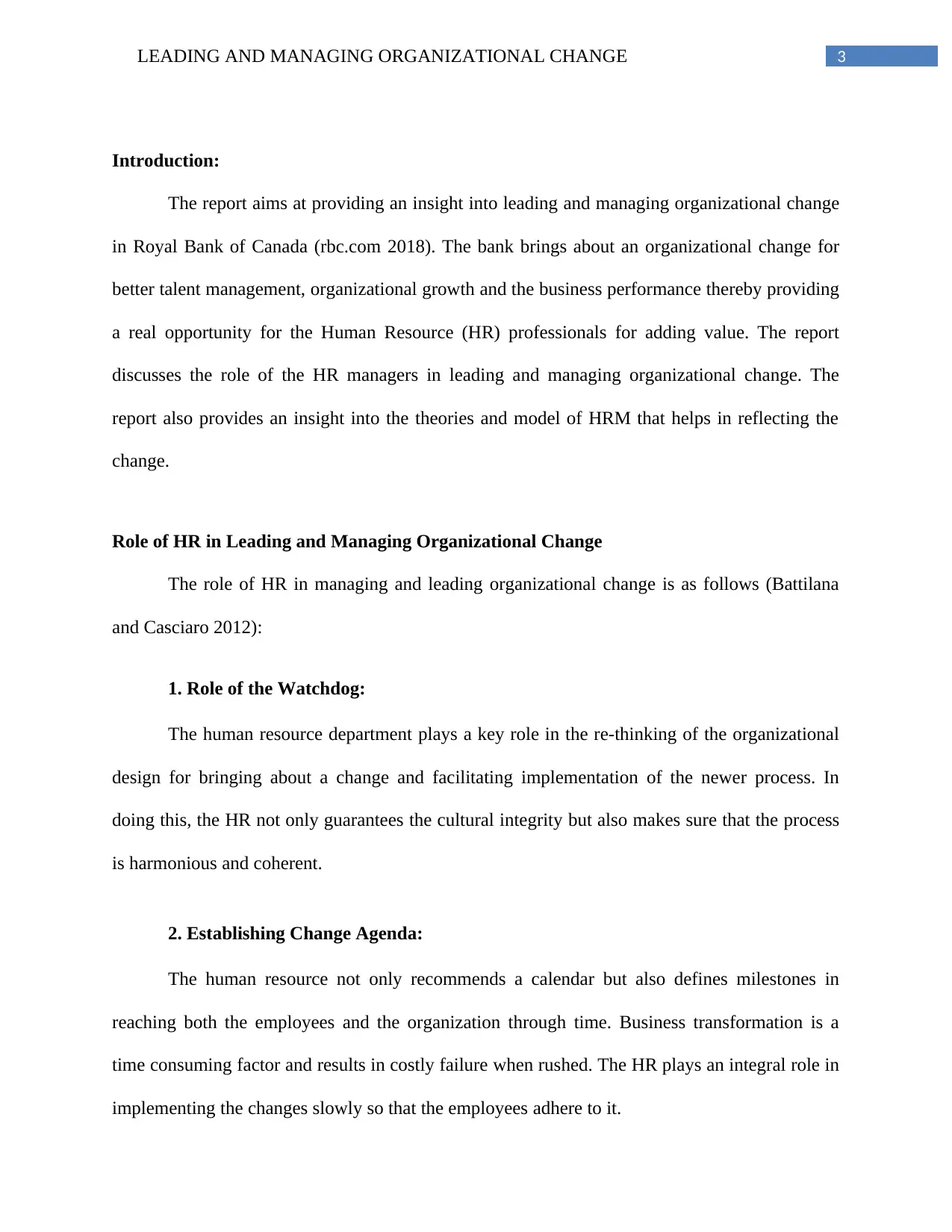
3LEADING AND MANAGING ORGANIZATIONAL CHANGE
Introduction:
The report aims at providing an insight into leading and managing organizational change
in Royal Bank of Canada (rbc.com 2018). The bank brings about an organizational change for
better talent management, organizational growth and the business performance thereby providing
a real opportunity for the Human Resource (HR) professionals for adding value. The report
discusses the role of the HR managers in leading and managing organizational change. The
report also provides an insight into the theories and model of HRM that helps in reflecting the
change.
Role of HR in Leading and Managing Organizational Change
The role of HR in managing and leading organizational change is as follows (Battilana
and Casciaro 2012):
1. Role of the Watchdog:
The human resource department plays a key role in the re-thinking of the organizational
design for bringing about a change and facilitating implementation of the newer process. In
doing this, the HR not only guarantees the cultural integrity but also makes sure that the process
is harmonious and coherent.
2. Establishing Change Agenda:
The human resource not only recommends a calendar but also defines milestones in
reaching both the employees and the organization through time. Business transformation is a
time consuming factor and results in costly failure when rushed. The HR plays an integral role in
implementing the changes slowly so that the employees adhere to it.
Introduction:
The report aims at providing an insight into leading and managing organizational change
in Royal Bank of Canada (rbc.com 2018). The bank brings about an organizational change for
better talent management, organizational growth and the business performance thereby providing
a real opportunity for the Human Resource (HR) professionals for adding value. The report
discusses the role of the HR managers in leading and managing organizational change. The
report also provides an insight into the theories and model of HRM that helps in reflecting the
change.
Role of HR in Leading and Managing Organizational Change
The role of HR in managing and leading organizational change is as follows (Battilana
and Casciaro 2012):
1. Role of the Watchdog:
The human resource department plays a key role in the re-thinking of the organizational
design for bringing about a change and facilitating implementation of the newer process. In
doing this, the HR not only guarantees the cultural integrity but also makes sure that the process
is harmonious and coherent.
2. Establishing Change Agenda:
The human resource not only recommends a calendar but also defines milestones in
reaching both the employees and the organization through time. Business transformation is a
time consuming factor and results in costly failure when rushed. The HR plays an integral role in
implementing the changes slowly so that the employees adhere to it.
Paraphrase This Document
Need a fresh take? Get an instant paraphrase of this document with our AI Paraphraser
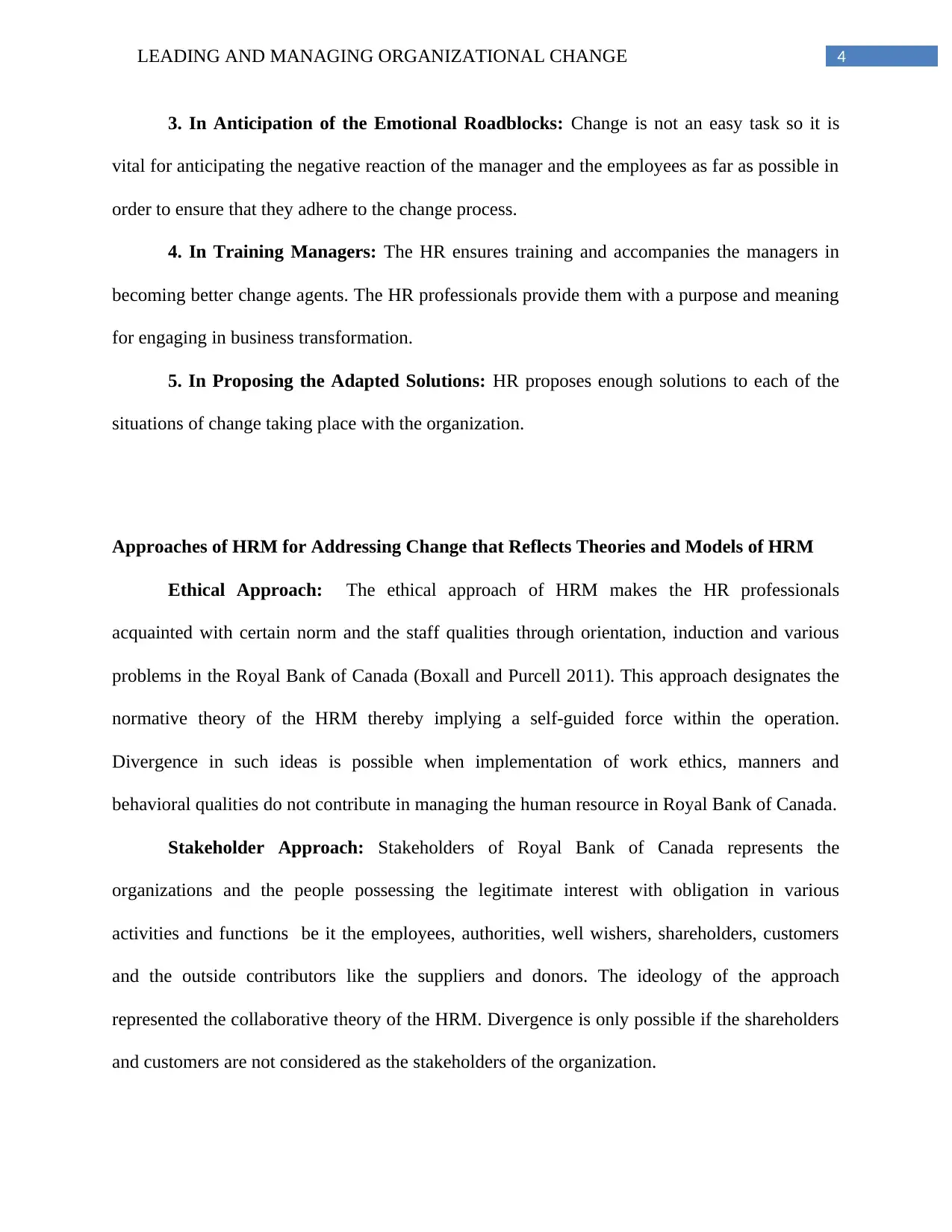
4LEADING AND MANAGING ORGANIZATIONAL CHANGE
3. In Anticipation of the Emotional Roadblocks: Change is not an easy task so it is
vital for anticipating the negative reaction of the manager and the employees as far as possible in
order to ensure that they adhere to the change process.
4. In Training Managers: The HR ensures training and accompanies the managers in
becoming better change agents. The HR professionals provide them with a purpose and meaning
for engaging in business transformation.
5. In Proposing the Adapted Solutions: HR proposes enough solutions to each of the
situations of change taking place with the organization.
Approaches of HRM for Addressing Change that Reflects Theories and Models of HRM
Ethical Approach: The ethical approach of HRM makes the HR professionals
acquainted with certain norm and the staff qualities through orientation, induction and various
problems in the Royal Bank of Canada (Boxall and Purcell 2011). This approach designates the
normative theory of the HRM thereby implying a self-guided force within the operation.
Divergence in such ideas is possible when implementation of work ethics, manners and
behavioral qualities do not contribute in managing the human resource in Royal Bank of Canada.
Stakeholder Approach: Stakeholders of Royal Bank of Canada represents the
organizations and the people possessing the legitimate interest with obligation in various
activities and functions be it the employees, authorities, well wishers, shareholders, customers
and the outside contributors like the suppliers and donors. The ideology of the approach
represented the collaborative theory of the HRM. Divergence is only possible if the shareholders
and customers are not considered as the stakeholders of the organization.
3. In Anticipation of the Emotional Roadblocks: Change is not an easy task so it is
vital for anticipating the negative reaction of the manager and the employees as far as possible in
order to ensure that they adhere to the change process.
4. In Training Managers: The HR ensures training and accompanies the managers in
becoming better change agents. The HR professionals provide them with a purpose and meaning
for engaging in business transformation.
5. In Proposing the Adapted Solutions: HR proposes enough solutions to each of the
situations of change taking place with the organization.
Approaches of HRM for Addressing Change that Reflects Theories and Models of HRM
Ethical Approach: The ethical approach of HRM makes the HR professionals
acquainted with certain norm and the staff qualities through orientation, induction and various
problems in the Royal Bank of Canada (Boxall and Purcell 2011). This approach designates the
normative theory of the HRM thereby implying a self-guided force within the operation.
Divergence in such ideas is possible when implementation of work ethics, manners and
behavioral qualities do not contribute in managing the human resource in Royal Bank of Canada.
Stakeholder Approach: Stakeholders of Royal Bank of Canada represents the
organizations and the people possessing the legitimate interest with obligation in various
activities and functions be it the employees, authorities, well wishers, shareholders, customers
and the outside contributors like the suppliers and donors. The ideology of the approach
represented the collaborative theory of the HRM. Divergence is only possible if the shareholders
and customers are not considered as the stakeholders of the organization.
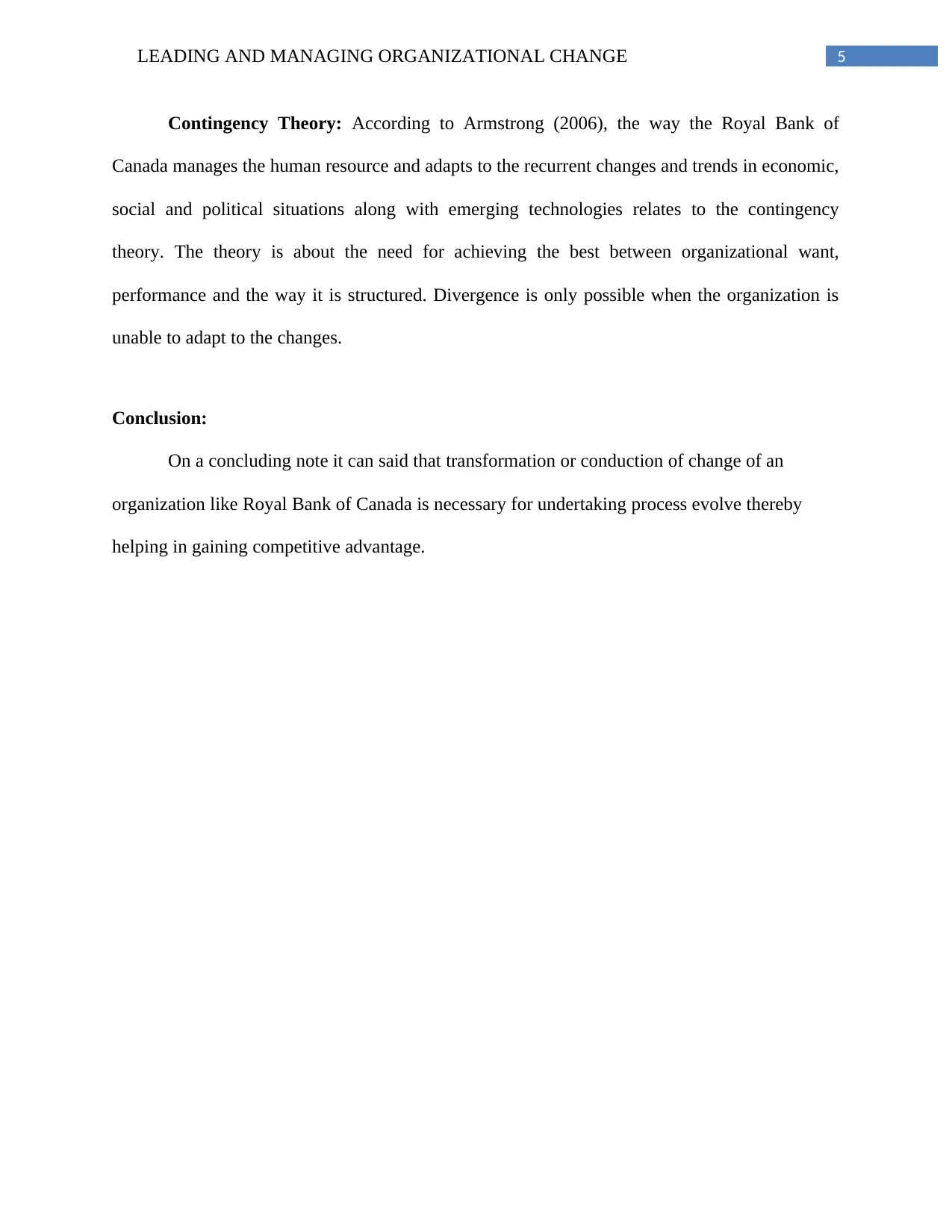
5LEADING AND MANAGING ORGANIZATIONAL CHANGE
Contingency Theory: According to Armstrong (2006), the way the Royal Bank of
Canada manages the human resource and adapts to the recurrent changes and trends in economic,
social and political situations along with emerging technologies relates to the contingency
theory. The theory is about the need for achieving the best between organizational want,
performance and the way it is structured. Divergence is only possible when the organization is
unable to adapt to the changes.
Conclusion:
On a concluding note it can said that transformation or conduction of change of an
organization like Royal Bank of Canada is necessary for undertaking process evolve thereby
helping in gaining competitive advantage.
Contingency Theory: According to Armstrong (2006), the way the Royal Bank of
Canada manages the human resource and adapts to the recurrent changes and trends in economic,
social and political situations along with emerging technologies relates to the contingency
theory. The theory is about the need for achieving the best between organizational want,
performance and the way it is structured. Divergence is only possible when the organization is
unable to adapt to the changes.
Conclusion:
On a concluding note it can said that transformation or conduction of change of an
organization like Royal Bank of Canada is necessary for undertaking process evolve thereby
helping in gaining competitive advantage.
You're viewing a preview
Unlock full access by subscribing today!
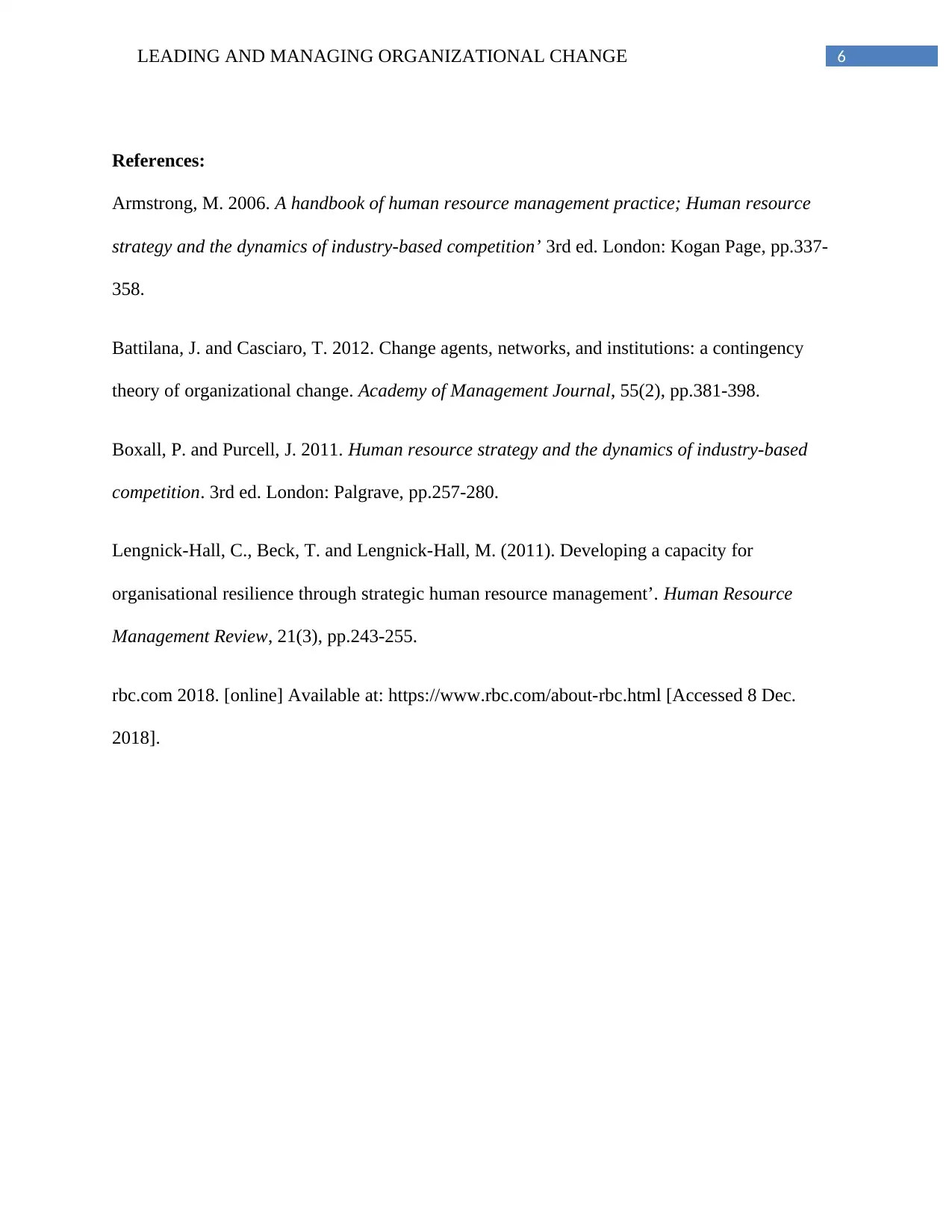
6LEADING AND MANAGING ORGANIZATIONAL CHANGE
References:
Armstrong, M. 2006. A handbook of human resource management practice; Human resource
strategy and the dynamics of industry-based competition’ 3rd ed. London: Kogan Page, pp.337-
358.
Battilana, J. and Casciaro, T. 2012. Change agents, networks, and institutions: a contingency
theory of organizational change. Academy of Management Journal, 55(2), pp.381-398.
Boxall, P. and Purcell, J. 2011. Human resource strategy and the dynamics of industry-based
competition. 3rd ed. London: Palgrave, pp.257-280.
Lengnick-Hall, C., Beck, T. and Lengnick-Hall, M. (2011). Developing a capacity for
organisational resilience through strategic human resource management’. Human Resource
Management Review, 21(3), pp.243-255.
rbc.com 2018. [online] Available at: https://www.rbc.com/about-rbc.html [Accessed 8 Dec.
2018].
References:
Armstrong, M. 2006. A handbook of human resource management practice; Human resource
strategy and the dynamics of industry-based competition’ 3rd ed. London: Kogan Page, pp.337-
358.
Battilana, J. and Casciaro, T. 2012. Change agents, networks, and institutions: a contingency
theory of organizational change. Academy of Management Journal, 55(2), pp.381-398.
Boxall, P. and Purcell, J. 2011. Human resource strategy and the dynamics of industry-based
competition. 3rd ed. London: Palgrave, pp.257-280.
Lengnick-Hall, C., Beck, T. and Lengnick-Hall, M. (2011). Developing a capacity for
organisational resilience through strategic human resource management’. Human Resource
Management Review, 21(3), pp.243-255.
rbc.com 2018. [online] Available at: https://www.rbc.com/about-rbc.html [Accessed 8 Dec.
2018].
1 out of 7
Related Documents
Your All-in-One AI-Powered Toolkit for Academic Success.
+13062052269
info@desklib.com
Available 24*7 on WhatsApp / Email
![[object Object]](/_next/static/media/star-bottom.7253800d.svg)
Unlock your academic potential
© 2024 | Zucol Services PVT LTD | All rights reserved.




